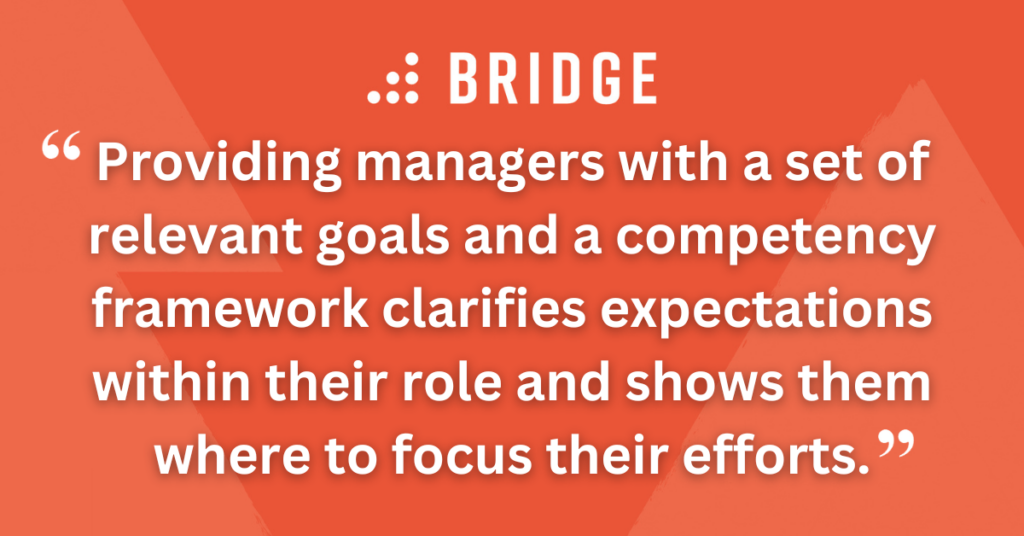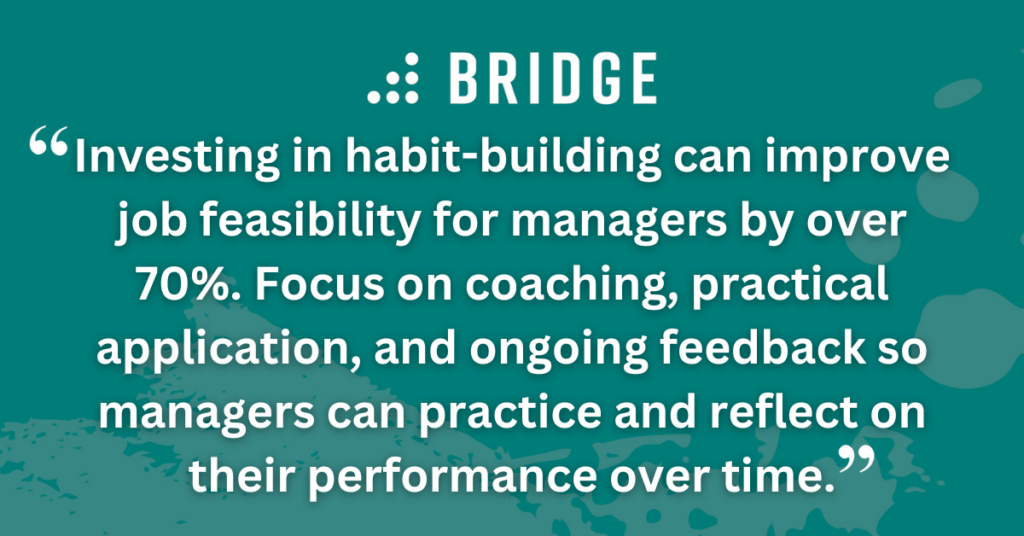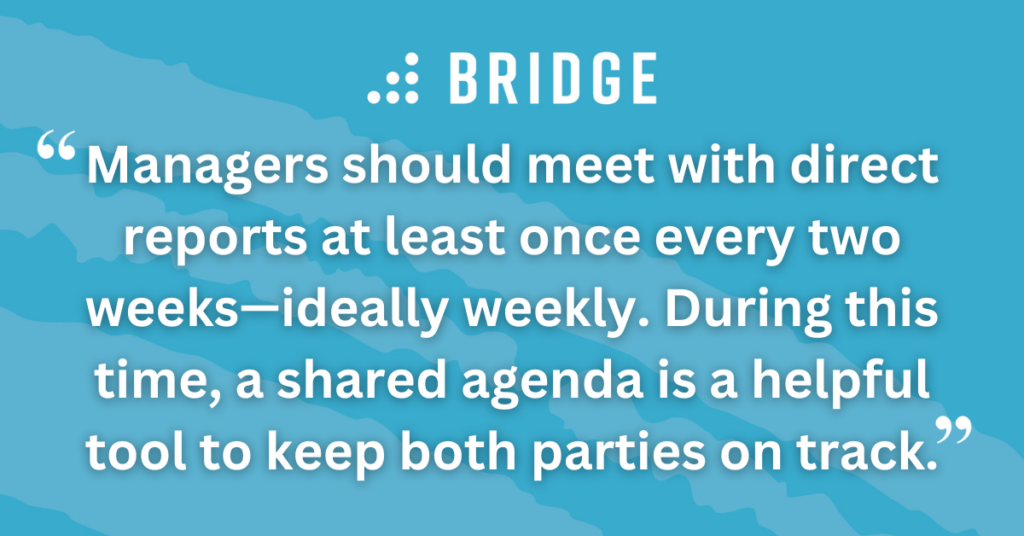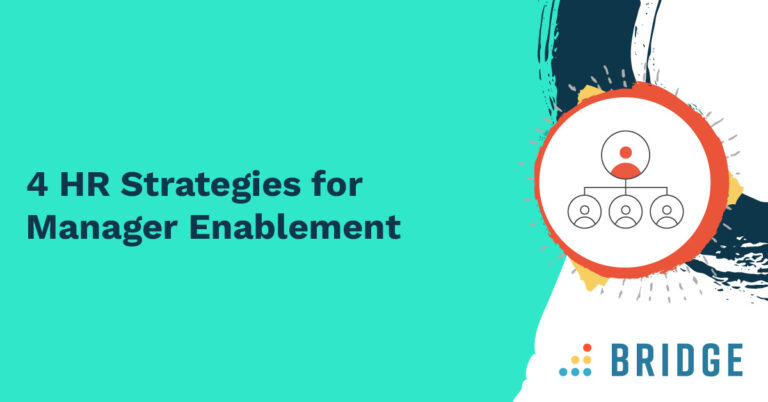Discover actionable ways to enable your people managers, help them develop their skills through ongoing development and practice, and drive employee engagement and productivity.
At the heart of your organization, your people managers play a central role in communicating strategy and inspiring success.
Managers are among your greatest allies when it comes to employee experience. Furthermore, according to survey data compiled in the Bridge-sponsored Future of Employee Engagement report, the relationship between managers and their direct reports has the largest influence over employee engagement, productivity, and retention.
HR Priorities for Manager Enablement Beyond Skills Development
The need for manager enablement is clear, and as organizations and employees give people managers more responsibilities, HR professionals have spotted a growing trend.
In a report compiled by Gartner, CHROs feel that managers within their organizations are taking on more and are overwhelmed by the growth of their remit and responsibilities.
Survey findings show that:
- The average manager has 51% more responsibility than they can juggle
- 45% are spending more time managing projects than people
- Only 25% say their organization’s skills development programs are fully effective
What’s more, despite survey respondents citing manager and leadership development as a top investment area for the organization, just 23% feel that their current investment in development has the desired results.
It takes more than training and skills development programs to help existing managers navigate their day-to-day responsibilities and show future leaders how to thrive in the role. You also need a framework to enable them to focus on high-value tasks and equip them with the skills to communicate and build relationships.
Read on for four areas where you can focus your efforts.

1) Clarify Role Expectations Through Goals
To measure manager effectiveness, you need a way to measure performance that you can tie to a set of goals. A RedThread survey of over 700 HR professionals uncovered some common practices that drive manager effectiveness, as well as proposing some appropriate measures of success.
Notably, organizations with successful managers and leaders take shared ownership of driving manager effectiveness by:
- Clarifying expectations through performance goals
- Showing managers the behaviors and competencies that define success
- Building interpersonal skills through ongoing coaching and feedback
Think about the high-value tasks your managers and leaders are uniquely positioned to perform and how you’ll measure proficiency. Providing managers with a set of relevant goals and a competency framework clarifies expectations within their role and shows them where to focus their efforts.
A development plan also maps future success, as people can use it to guide their training and connect with peers to find stretch assignments and mentors. Employees who desire to move into leadership roles in the future should have well-defined and actionable career development plans that orientate them toward these goals.
SEE WHAT SKILLS YOUR PEOPLE POSSESS | ‘Skills Mapping 101: How to Visualize Employee Capabilities’
2) Simplify Management Processes
Employees need to know they’re doing their best work and equally, where they can improve and grow—and managers are in an ideal position to offer this insight.
Cut Down On Time-Consuming Tasks
When managers are busy, it's easy to let tasks like performance reviews and check-ins fall by the wayside or become another item on the extended to-do list. The right tools can free them to focus on their people.
An all-in-one learning and performance platform like Bridge helps make processes like performance management a habit. This, in turn, means it's easy for managers to stay on track with their teams' tasks, schedule training at the point of need, and draw on conversations to complete performance reviews with ease.
Keep Goals Visible and Easy to Track
Are your employees meeting key deliverables? Are there any roadblocks slowing progress? Managers play a role in keeping projects moving and making sure employees are on target.
When performance goals are transparent and aligned with company-wide initiatives, every employee is able to track and measure their impact. That means they’re able to take ownership of their performance, using data to keep them aligned with team and company goals and seeking out development opportunities.

Tie Your People Data Together
Access to team-specific analytics within a single dashboard instantly shows managers a view of development, employee engagement and performance, and areas that aren’t always immediately visible to them.
With detailed and in-the-moment information, they’re able to spot patterns and trends, see what’s influencing employee engagement or where skills gaps exist, leading to proactive decision-making. This visual insight can also enhance conversations and inform feedback.
KEEP READING | ‘Continuous Feedback: The Key to the Best Performance Reviews’
3) Develop Managers With the Experience to Lead
Effective manager and leadership training should be personal, relevant to each learner's needs, and actionable within their role.
Reinforce Leadership Behaviors Through On-the-Job Practice
To teach and reinforce soft skills and leadership behaviors, managers need a learning environment in which they can immediately apply skills to real-world situations.
Evidence suggests that investing in habit-building can improve job feasibility for managers by over 70%. Focus on coaching, practical application, and ongoing feedback so managers can practice and reflect on their performance over time.
Break down training into desired behaviors and reinforce learning through practical application and evidence-based tasks. You can also bolster existing L&D programs using on-the-job practice and situation-based training. With a group of learners advancing toward the same goal, you create a safe environment where learners can practice applying skills and share feedback.
READ MORE ABOUT MANAGER DEVELOPMENT | ‘5 Ways to Build Leadership Development Programs With Bridge Journeys’
Embed Coaching Into Your Culture
Establishing mentor networks across the organization gives your learners the chance to connect with skilled peers, and learn through experience, observation, and targeted feedback.
To optimize your manager development programs, you should connect managers with a coach or mentor who knows the role, the expected behaviors and skills, and can observe their performance. They should offer expert advice, improve communication skills, and guide them through some of the scenarios they're likely to encounter, such as:
- Engaging in effective conversation
- Giving and receiving feedback
- Developing employees
- Setting and tracking goals
- Handling conflict
FIND OUT MORE | ‘Mentoring 101: Planning the Perfect Mentorship Program’
Set and Track Personal Development Goals
If you want managers to be people-oriented, your focus should be on their personal goals, boosting their confidence in areas they feel they're lacking, and supporting them in areas they need advancement.
Regular development conversations keep your managers on track and their goals aligned with company objectives. After reviewing their performance and reflecting on feedback with a manager or a mentor, adjust learning and development pathways based on their individual needs and make sure goals are relevant.

4) Make Manager-Employee Conversations a Habit
Managers must be skilled communicators who can foster relationships and personalize their communication style.
Keep Feedback Flowing
Feedback should be more than an afterthought, and people should always be aware of how they're developing and where they can improve. Managers are well-placed to offer actionable guidance, and for nearly one-third of employees, this is the most valuable source of recognition, according to Gallup data.
Scheduling manager-employee check-ins for key points during learning journeys or after a skills assessment can make these conversations especially relevant while ensuring they never fall by the wayside.
Discussions should reflect on the things employees did well, review any areas for improvement, and provide practical advice they can use going forward.
ADDITIONAL INSIGHTS | ‘Continuous Feedback: The Key to the Best Performance Reviews’
Create One-on-One Agendas
Managers should meet with direct reports at least once every two weeks—ideally weekly. During this time, a shared agenda is a helpful tool to keep both parties on track and productive.
Share a template that each party can contribute to each week. This way, they can track their meetings and make sure they cover all key points.
Your one-on-one agenda should include:
- Tasks: A list of current projects and action items
- Goals: How employees are performing
- Achievements: Any positive feedback or wins
- Learning: Recommendations for training that would benefit employees
- Any other topics: A space to list any other points they’d like to cover
MAKE MANAGER-EMPLOYEE CHECK-INS MEANINGFUL | ‘Unlock Your Employees’ Potential With People-First Managers’
Use Discussion Prompts and Conversation Starters
Personalized communication is key for managers to establish strong relationships with team members, and Bridge’s platform helps managers steer conversations and strengthen their skills with a set of recommended questions, prompts, and templates.
Bridge Career Drivers, an interactive card game, serves as an effective trust-building tool between managers and direct reports, prompting deeper insight into employee engagement, career goals, and motivations.
DISCOVER WHAT DRIVES EMPLOYEES WITH BRIDGE CAREER DRIVERS | ‘A 3-Step Workbook for Managers to Find Out What Drives Their People’
Empower Your Managers With Bridge’s LMS
Give your managers the tools they need to drive employee development with Bridge’s learning and development platform.
Bridge offers an award-winning learning management system and performance platform in one unified experience. Employee development and engagement is at the heart of everything we do. Design and deliver training programs, and take learning to a new level with tools designed to make conversations about workplace performance easier.
Bridge has helped thousands of organizations worldwide drive growth by bringing learning, skill building, and employee engagement together in one easy-to-use platform.




